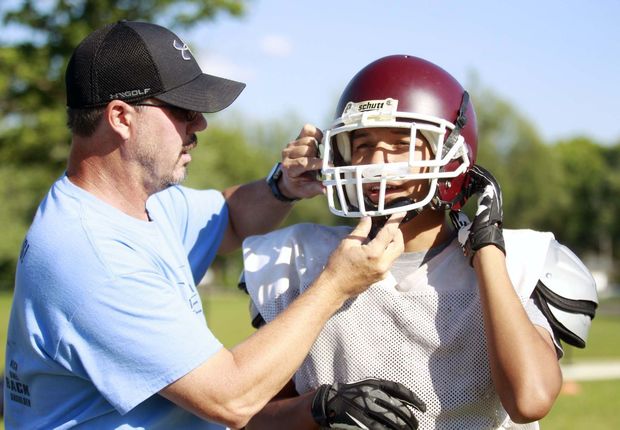
Bigger, faster, stronger isn’t just a mantra that’s being emphasized during summer conditioning.
The evolution of today’s high school football player has had an impact on injuries, injury treatment and prevention.
“There’s more of a role and need of the athletic trainer out there because the kids are getting bigger, the hitting is getting bigger,” said David Fricke, Waterloo West’s head athletic trainer since 1996. “There’s a high chance, I think, for injuries. Injuries are evolving where the knowledge is needed out on the field to help coaches and athletes.”
Fricke has been contracted through Cedar Valley Medical Specialists to serve West High’s athletic training needs. The veteran trainer travels with the football team, covers practices and has daily in-season training room hours at the school.
He also helps arrange athletic training coverage for other local schools. Cedar Valley Medical Specialists covers Cedar Falls, Waterloo East and Columbus with one trainer assigned to a school working hours that can range up to that of a part-time teacher.
“I meet with administration and have done so for many years and contract out the services,” Fricke said. “We figure out how many hours that the school wants provided and come up with a figure that is negotiated by the school system and us.”
The role of athletic trainers at high schools has evolved from being on hand and diagnosing injuries during Friday night football games to serving all sports, providing preventative care and more regular rehab and treatment.
Scott Lockard was named the Iowa Athletic Trainers’ Society Secondary School Athletic Trainer of the Year for 2015. He provided coverage to Waterloo Columbus for eight years and is working with Don Bosco’s school district this year.
Lockard says his work with teams at Columbus would begin with preseason conditioning.
“We would be able to determine whether or not certain athletes were predisposed to injuries based on their body types and whatnot,” Lockard said. “We could kind of pick kids out and determine if we needed to work with them more strength-wise to prevent injuries.”
Since starting at West in the late 90s, Fricke says there have been changes in how various injuries are being treated and evaluated.
“Within football, my role is to lessen the coach’s duty having to deal with injuries,” Fricke said. “We guide the athletes and parents on which way to go with their injury. We do evaluation on the field, in the athletic training room, and then guide athletes so they hopefully get the best care they can get without having to sit around or wait.”
Common equipment you’ll see on site with trainers these days includes bracing, splints and even AED’s (Automated External Defibrillator) in case there’s some type of cardiac emergency.
“With some younger athletes there sometimes is a time when you might have to do CPR or might have a heart condition that an AED is utilized,” Fricke said. “You read each year there’s some type of catastrophic injury or ailment that needs the athletic trainer right there on site. That athlete might stop breathing or have some type of heart ailment that goes undiagnosed, or it goes diagnosed but you can still participate as long as the athlete is on the medicine.”
While larger schools typically can afford more coverage from athletic trainers, smaller schools are starting to place the service as a priority.
Dike-New Hartford’s booster club has helped the school bring on a part-time athletic trainer through Athletico Physical Therapy in Cedar Falls for the upcoming year. Destry Sperslage has been contracted to supply year-round training services for all sports and weightlifting.
“We’re real fortunate this year,” D-NH head football coach Don Betts said. “In the past, we’ve had a trainer who has been there on the sideline with us on Friday nights, but not really at practice.
“We’re really excited to have somebody who is available during practice as opposed to coaches having to fly by the seat of their pants on that. It takes such a burden off our coaching staff to have somebody who is trained and a certified professional at practice.”
As Fricke points out, many schools in Iowa are still not covered by athletic trainers.
“The last numbers I saw it was just 50 percent of the schools in the state of Iowa have some type of athletic training, especially more for football,” Fricke said. “It sometimes is difficult (to afford). In some of the smaller schools they have a chiropractor or some other professional that comes out to cover. It’s based on the community and the services that community can provide.”
ORIGINAL ARTICLE:
http://wcfcourier.com/sports/high-school/football/fall-preview/prep-football-preview-trainers-becoming-impact-players-on-prep-scene/article_8404d127-a71c-51fd-9598-61b4fb7f26dc.html